Bush Hog 3226QT, 2846, 2426, 2446 User Manual

BUSH HOG®
2426, 2446, 2846 & 3226QT Front End Loaders Operator’s Manual
ASSEMBLY • OPERATION • MAINTENANCE
707 |
$4.00 |
25H49393 |
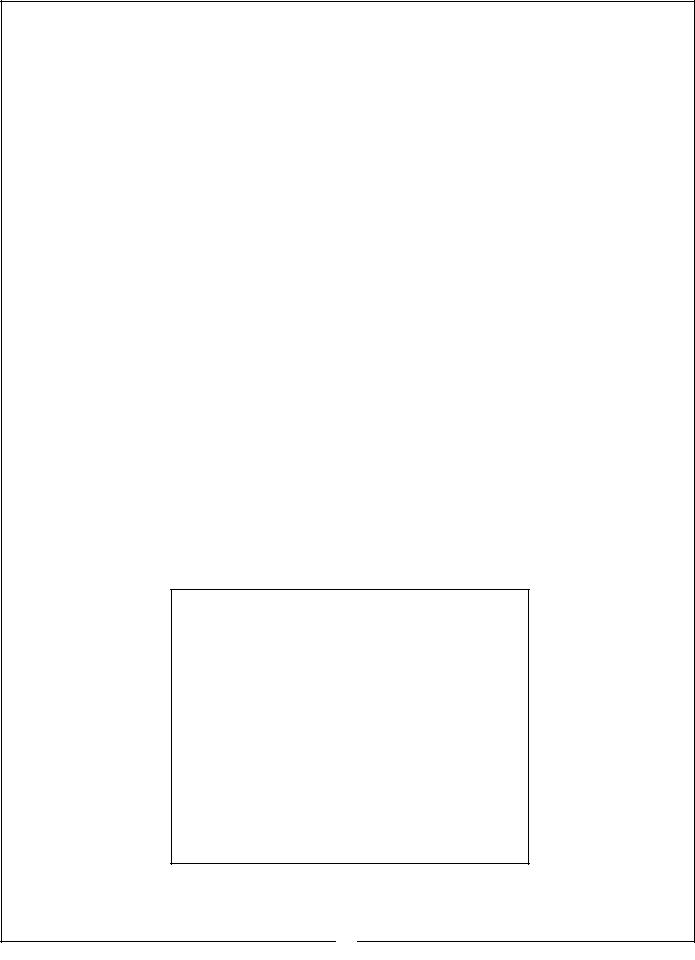
CONGRATULATIONS!
You have invested in the best implement of its type on the market today.
The care you give your Bush Hog implement will greatly determine your satisfaction
with its performance and its service life. We urge a careful study of this manual to provide you with a thorough understanding of your new implement before operating, as well as suggestions for operation and maintenance.
If your manual should become lost or destroyed, Bush Hog will be glad to provide you with a new copy. Order from Bush Hog, P. O. Box 1039, Selma, Alabama 36702-1039. Most of our manuals can also be downloaded from our website at www.bushhog.com.
As an authorized Bush Hog dealer, we stock genuine Bush Hog parts which are manufactured with the same precision and skill as our original equipment. Our trained service personnel are well informed on methods required to service Bush Hog equipment, and are ready and able to help you.
Should you require additional information or assistance, please contact us.
YOUR AUTHORIZED
BUSH HOG DEALER
BECAUSE BUSH HOG MAINTAINS AN ONGOING
PROGRAM OF PRODUCT IMPROVEMENT, WE
RESERVE THE RIGHT TO MAKE IMPROVEMENTS IN
DESIGN OR CHANGES IN SPECIFICATIONS WITH-
OUT INCURRING ANY OBLIGATION TO INSTALL
THEM ON UNITS PREVIOUSLY SOLD.
BECAUSE OF THE POSSIBILITY THAT SOME
PHOTOGRAPHS IN THIS MANUAL WERE TAKEN OF
PROTOTYPE MODELS, PRODUCTION MODELS MAY
VARY IN SOME DETAIL. IN ADDITION, SOME
PHOTOGRAPHS MAY SHOW SHIELDS REMOVED
FOR PURPOSES OF CLARITY. NEVER OPERATE
THIS IMPLEMENT WITHOUT ALL SHIELDS IN PLACE.
1
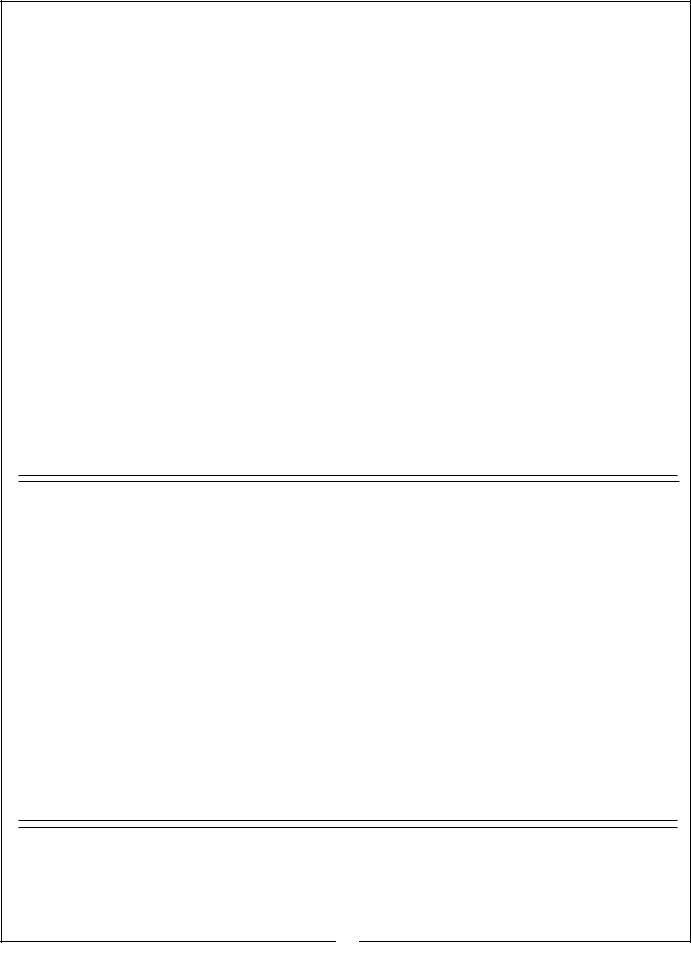
2426, 2446, 2846 & 3226 QT
TABLE OF CONTENTS
SECTION/PARA |
PAGE |
SECTION/PARA |
PAGE |
|
Warranty ..................................................... |
3 |
|
|
Dealer Preparation Check List.................... |
4 |
|
|
Safety Precautions...................................... |
5 |
|
|
Federal Laws & Regulations....................... |
7 |
|
I |
INTRODUCTION & DESCRIPTION ........... |
8 |
|
|
1-1 Introduction........................................... |
8 |
|
|
1-2 Description............................................ |
8 |
|
II |
LOADER MOUNTING & DISMOUNTING.10 |
||
|
2-1 Preparing Tractors.............................. |
10 |
|
|
2-2 Mounting Loader................................. |
10 |
|
|
2-3 Dismounting Loader ........................... |
12 |
|
III |
OPERATING INSTRUCTIONS................. |
13 |
|
|
3-1 General Safety.................................... |
13 |
|
|
3-2 Operation............................................ |
13 |
|
|
3-3 |
Bale Spear Operation ......................... |
18 |
|
3-4 |
Fork Lift Operation.............................. |
19 |
|
3-5 |
Quick Hitch Operation......................... |
19 |
|
3-6 |
Transporting........................................ |
19 |
IV |
MAINTENANCE ...................................... |
20 |
|
4-1 Maintenance Check List..................... |
20 |
|
4-2 Lubrication.......................................... |
20 |
|
4-3 Hydraulic System |
|
|
Pressure Requirements...................... |
21 |
|
4-4 Troubleshooting ................................. |
21 |
V |
ASSEMBLY .............................................. |
23 |
|
5-1 Mainframe Assembly.......................... |
23 |
|
5-2 Hydraulic Valve Stand Assembly ....... |
25 |
|
5-3 Hydraulic Valve Plumbing .................. |
26 |
|
5-4 Power Beyond Plumbing.................... |
27 |
|
5-5 Fork Lift Option................................... |
28 |
|
5-6 Bale Spear ......................................... |
28 |
|
5-7 Bucket Items ...................................... |
29 |
|
Safety Decals ........................................... |
30 |
|
Torque Specifications............................... |
31 |
OPTIONAL EQUIPMENT INSTRUCTIONS |
|
|
|
Hydraulic Self Leveling |
|
|
Cable Control |
|
|
Selector Valve |
|
|
Grapple Fork |
|
RETAIL CUSTOMER’S RESPONSIBILITY
UNDER THE BUSH HOG WARRANTY
It is the Retail Customer and/or Operator’s responsibility to read the Operator’s Manual, to operate, lubricate, maintain and store the product in accordance with all instructions and safety procedures. Failure of the operator to read the Operator’s Manual is a misuse of this equipment.
It is the Retail Customer and/or Operator’s responsibility to inspect the product and to have any part(s) repaired or replaced when continued operation would cause damage or excessive wear to other parts or cause a safety hazard.
It is the Retail Customer’s responsibility to deliver the product to the authorized Bush Hog
Dealer, from whom he purchased it, for service or replacement of defective parts which are covered by warranty. Repairs to be submitted for warranty consideration must be made within forty-five (45) days of failure.
It is the Retail Customer’s responsibility for any cost incurred by the Dealer for traveling to or hauling of the product for the purpose of performing a warranty obligation or inspection.
DANGER: Indicates an imminently hazardous situation which, if not avoided, will result in death or serious injury. This signal word is to be limited to the most extreme situations.
UNDERSTAND SIGNAL WORDS
WARNING: Indicates a potentially |
CAUTION: Indicates a potentially haz- |
hazardous situation which, if not |
ardous situation which, if not avoided, |
avoided, could result in death or |
may result in minor or moderate injury. It |
serious injury. |
may also be used to alert against |
|
unsafe practices. |
|
2
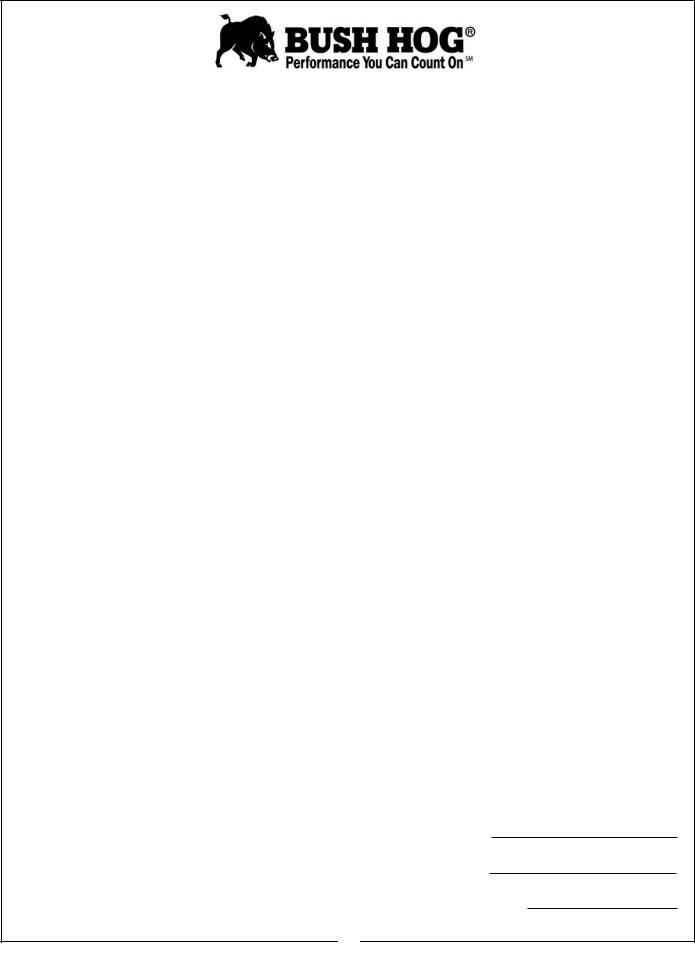
LIMITED WARRANTY
OOOOOOOOOOOOOOOOOOOOOOOOOOOOOOO
Bush Hog warrants to the original purchaser of any new Bush Hog equipment, purchased from an authorized Bush Hog dealer, that the equipment be free from defects in material and workmanship for a period of one (1) year for non-commercial, state, and municipalities’ use and ninety (90) days for commercial use from date of retail sale. The obligation of Bush Hog to the purchaser under this warranty is limited to the repair or replacement of defective parts.
Replacement or repair parts installed in the equipment covered by this limited warranty are warranted for ninety (90) days from the date of purchase of such part or to the expiration of the applicable new equipment warranty period, whichever occurs later. Warranted parts shall be provided at no cost to the user at an authorized Bush Hog dealer during regular working hours. Bush Hog reserves the right to inspect any equipment or parts which are claimed to have been defective in material or workmanship.
DISCLAIMER OF IMPLIED WARRANTIES & CONSEQUENTIAL DAMAGES
Bush Hog’s obligation under this limited warranty, to the extent allowed by law, is in lieu of all warranties, implied or expressed, INCLUDING IMPLIED WARRANTIES OF MERCHANTABILITY AND FITNESS FOR A PARTICULAR PURPOSE and any liability for incidental and consequential damages with respect to the sale or use of the items warranted. Such incidental and consequential damages shall include but not be limited to: transportation charges other than normal freight charges; cost of installation other than cost approved by Bush Hog; duty; taxes; charges for normal service or adjustment; loss of crops or any other loss of income; rental of substitute equipment, expenses due to loss, damage, detention or delay in the delivery of equipment or parts resulting from acts beyond the control of Bush Hog.
THIS LIMITED WARRANTY SHALL NOT APPLY:
1.To vendor items which carry their own warranties, such as engines, tires, and tubes.
2.If the unit has been subjected to misapplication, abuse, misuse, negligence, fire or other accident.
3.If parts not made or supplied by Bush Hog have been used in connection with the unit, if, in the sole judgement of Bush Hog such use affects its performance, stability or reliability.
4.If the unit has been altered or repaired outside of an authorized Bush Hog dealership in a manner which, in the sole judgement of Bush Hog, affects its performance, stability or reliability.
5.To normal maintenance service and normal replacement items such as gearbox lubricant, hydraulic fluid, worn blades, or to normal deterioration of such things as belts and exterior finish due to use or exposure.
6.To expendable or wear items such as teeth, chains, sprockets, belts, springs and any other items that in the company’s sole judgement is a wear item.
NO EMPLOYEE OR REPRESENTATIVE OF BUSH HOG IS AUTHORIZED TO CHANGE THIS LIMITED WARRANTY IN ANY WAY OR GRANT ANY OTHER WARRANTY UNLESS SUCH CHANGE IS MADE IN WRITING AND SIGNED BY BUSH HOG’S SERVICE MANAGER, POST OFFICE BOX 1039, SELMA, ALABAMA 36702-1039.
OOOOOOOOOOOOOOOOOOOOOOOOOOOOOOO
Record the model number, serial number and date purchased. This information will be helpful to your dealer if parts or service are required.
MAKE CERTAIN THE WARRANTY REGISTRATION CARD HAS BEEN FILED WITH BUSH HOG/
SELMA, ALABAMA
MODEL NUMBER
SERIAL NUMBER
DATE OF RETAIL SALE
3

DEALER PREPARATION CHECK LIST
2426, 2446, 2846 & 3226 QT LOADERS
BEFORE DELIVERING MACHINE - The following check list should be completed. Use the Operator’s Manual as a guide.
oMachine properly assembled.
oAll safety decals readable. (See decal page)
oAll bolts tightened to torque specifications given in torque chart.
oMachine operates properly.
oCustomer has appropriate mounting kit for his tractor and loader.
oCustomer has appropriate attachments for loader operations. ( Buckets for lifting loose materials; bale spear for lifting round bales; fork lift for lifting palletized material)
 CAUTION
CAUTION
IT IS RECOMMENDED THAT TRACTOR BE
EQUIPPED WITH ROLLOVER PROTECTIVE SYS-
TEM (ROPS) AND SEAT BELT BE USED FOR ALL
LOADER OPERATIONS.
oOperators manual has been delivered to owner and he has been instructed on the safe and proper use of the front end loader.
Dealer’s Signature
THIS CHECK LIST TO REMAIN IN OPERATOR’S MANUAL
It is the responsibility of the dealer to complete the procedures listed above before delivery of this implement to the customer.
4

IMPORTANT SAFETY PRECAUTIONS
This symbol is used to call attention to safety precautions that should be followed by the operator to avoid accidents. When you see this symbol, carefully read the message that follows and heed its advice. Failure to comply with safety precautions could result in serious bodily injury.
In addition to the design and configuration of equipment, hazard control and accident prevention are dependent upon the awareness, concern, prudence and proper training of personnel in the operation, transport, maintenance and storage of equipment. Lack of attention to safety can result in accident, personal injury, reduction of efficiency and worst of all—loss of life. Watch for safety hazards and correct deficiencies promptly. Use the following safety precautions as a general guide to safe operations when using this machine. Additional safety precautions are used throughout this manual for specific operating and maintenance procedures. Read this manual and review the safety precautions often until you know the limitations.
THE TRACTOR
1.Read the tractor operator’s manual to learn how to operate your tractor safely. Failure to do so could result in serious injury or death and equipment damage.
2.It is recommended that tractor be equipped with Rollover Protective System (ROPS) and a seat belt be used for all loader operations.
3.Add wheel ballast or rear weight for stability.
4.Move wheels to the tractor manufacturer’s widest recommended settings to increase stability.
5.For better stability, use tractor with wide front axle rather than tricycle front wheels.
6.Move and turn the tractor at low speeds.
7.Stop tractor engine, place transmission in park (or neutral), engage parking brake, lower loader arms to ground, cycle all hydraulic controls to relieve pressure, allow machine moving parts to stop, remove ignition key to prevent unauthorized person from starting engine before dismounting tractor or servicing, repairing, or making adjustments to the equipment.
8.Wear personal protective equipment (PPE), such as, but not limited to, protection for eyes, ears, lungs, head, hands and feet when operating, servicing, or repairing equipment. Avoid wearing loose clothing or jewelry that may catch and entangle on equipment moving parts.
THE LOADER
1.Read the loader operator’s manual to learn how to operate your loader safely. Failure to do so could result in serious injury or death and equipment damage.
2.Become familiar with all the machine’s controls and all the caution, warning and danger decals affixed to the machine before attempting to start or operate.
3.Improper use of a loader can cause serious injury or death.
4.Do not lift or carry anybody on the loader or in the bucket or attachment.
5.Never allow anyone to get under the loader bucket or reach through the booms when the bucket is raised.
6.Do not walk or work under a raised loader bucket or attachment unless it is is securely blocked or held in position
7.Avoid overhead wires and obstacles when loader is raised. Contacting electrical lines can cause electrocution.
8.Make sure all parked loaders on stands are on a hard, level surface.
9.Use a piece of cardboard or wood rather than hands and wear eye protection when searching for hydraulic leaks. Escaping hydraulic oil under pressure can penetrate skin. If oil is injected into skin, it must be surgically removed within a few hours by a doctor or gangrene may result.
5

SAFETY PRECAUTIONS CONTINUED
10.Before disconnecting hydraulic lines, relieve all hydraulic pressure.
11.Do not tamper with the relief valve setting. The relief valve is pre-set at the factory. Changing the setting can cause overloading the loader and tractor and serious operator injury may result.
12.Always wear safety goggles when repairing or servicing machine.
13.When servicing or replacing pins in cylinder ends, buckets, etc., always use a brass drift and hammer. Failure to do so could result in injury from flying fragments.
14.Replace damaged or illegible safety decals. See decal page for required decals.
15.Do not modify or alter or permit anyone else to modify or alter the loader, any of its components or any loader function without first consulting your local dealer.
OPERATING THE LOADER
1.It is the loader owner’s responsibility to instruct and have a person read operator’s manual, safety decals and become familiar with machine controls before allowing them to operate loader.
2.Do not allow children to operate the loader.
3.Before starting or operating the equipment, make a walk around inspection and check for loose or damaged components. Correct any deficiency before starting.
4.Keep the area of operation clear of all persons, particularly small children. The operator should cease operation whenever anyone comes within the operating area.
5.Operate the loader from the “Operator’s Seat Only.”
6.Exercise caution when operating the loader with a raised loaded bucket, fork, or large round hay bale handling attachments.
7.Avoid loose fill, rocks and holes. They can be dangerous for loader operation or movement.
8.Be extra careful when working on inclines.
9.Allow for the loader length when making turns.
10.Stop the loader arms gradually when lowering or lifting.
11.Use caution when handling loose or shiftable loads.
12.Carry loader arms at a low position during transport.
13.Lower loader arms, stop engine, and lock brakes before leaving the tractor seat.
14.Operate the loader controls only when properly seated at the controls.
15.Do not use loader for handling large, heavy objects such as logs, oil drums, etc.
16.Handling large, heavy objects is dangerous due to: *Possibility of rolling the tractor over.
*Possibility of upending the tractor.
*Possibility of the object rolling or sliding down the loader arms onto the operator.
17.Use large round hay bale handler attachment with bale retaining devices (grapples, bale spears, clamps, etc.) to handle large round hay bales. Failure to use retaining devices could allow round hay bales to roll or fall down loader boom arms onto the operator causing serious injury or death and equipment damage.
6

IMPORTANT FEDERAL LAWS AND REGULATIONS* CONCERNING
EMPLOYERS, EMPLOYEES AND OPERATIONS.
*(This section is intended to explain in broad terms the concept and effect of the following federal laws and regulations. It is not intended as a legal interpretation of the laws and should not be considered as such).
U.S. Public Law 91-596 (The Williams-Steiger Occupational and Health Act of 1970) OSHA
This Act Seeks:
“...to assure so far as possible every working man and woman in the nation safe and healthful working conditions and to preserve our human resources...”
DUTIES
Sec. 5 (a) Each employer—
(1)shall furnish to each of his employees employment and a place of employment which are free from recognized hazards that are causing or are likely to cause death or serious physical harm to his employees;
(2)shall comply with occupational safety and health standards promulgated under this Act.
(b)Each employee shall comply with occupational safety and health standards and all rules, regulations and orders issued pursuant to this Act which are applicable to his own actions and conduct.
OSHA Regulations
Current OSHA regulations state in part: “At the time of initial assignment and at least annually thereafter, the employer shall instruct every employee in the safe operation and servicing of all equipment with which the employee is, or will be involved.” These will include (but are not limited to) instructions to:
Keep all guards in place when the machine is in operation;
Permit no riders on equipment;
Stop engine, disconnect the power source, and wait for all machine movement to stop before servicing, adjusting, cleaning or unclogging the equipment, except where the machine must be running to be properly serviced or maintained, in which case the employer shall instruct employees as to all steps and procedures which are necessary to safely service or maintain the equipment.
Make sure everyone is clear of machinery before starting the engine, engaging power, or operating the machine.
EMPLOYEE TRACTOR OPERATING INSTRUCTIONS:
1.Securely fasten your seat belt if the tractor has a ROPS.
2.Where possible, avoid operating the tractor near ditches, embankments, and holes.
3.Reduce speed when turning, crossing slopes, and on rough, slick, or muddy surfaces.
4.Stay off slopes too steep for safe operation.
5.Watch where you are going, especially at row ends, on roads, and around trees.
6.Do not permit others to ride.
7.Operate the tractor smoothly - no jerky turns, starts, or stops.
8.Hitch only to the drawbar and hitch points recommended by tractor manufacturers.
9.When tractor is stopped, set brakes securely and use park lock if available.
Child Labor Under 16 Years Old
Some regulations specify that no one under the age of 16 may operate power machinery. It is your responsibility to know what these regulations are in your own area or situation. (Refer to U.S. Dept. of Labor, Employment Standard Administration, Wage & Home Division, Child Labor Bulletin #102.)
7
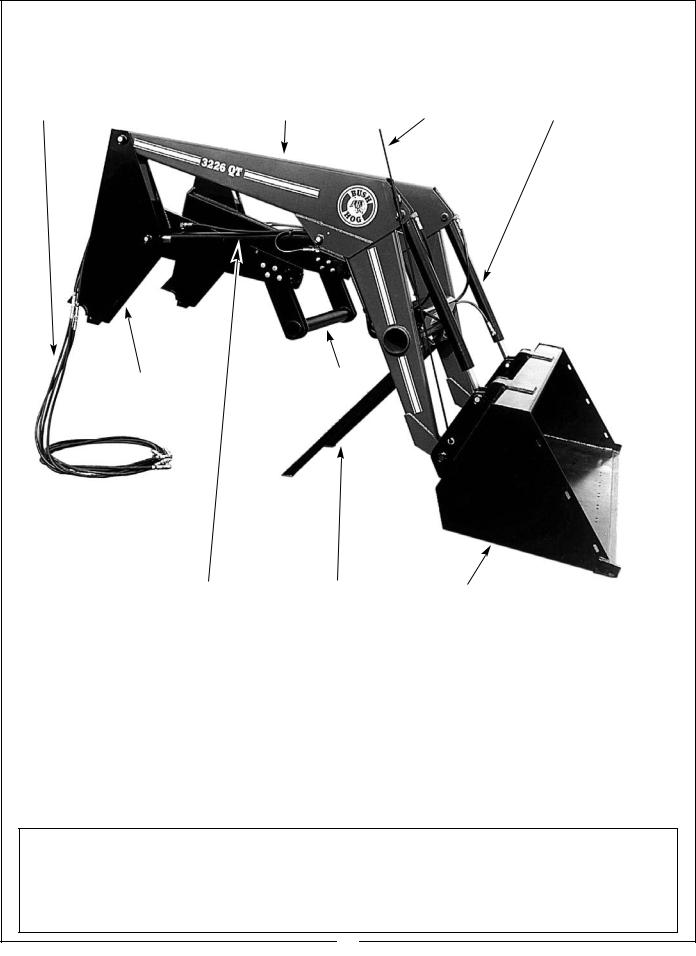
SECTION I
INTRODUCTION AND DESCRIPTION
Figure 1-1 Major Components
Hydraulic Hoses |
Mainframe Boom |
Level Indicator |
Bucket Cylinder |
|
|
Cross Tube |
|
Subframe |
|||
|
|
||
|
|
|
|
Boom Cylinder |
Parking Stands |
Bucket |
|
|
|
|
1-1 INTRODUCTION |
|
1-2 DESCRIPTION |
|
We are pleased to have you as a Bush Hog customer. Your Front End Loader has been carefully designed to give maximum service with minimum down time. This manual is provided to give you the necessary operating and maintenance instructions for keeping your front end loader in top operating condition. Please read this manual thoroughly. Understand what each control is for and how to use it. Observe all safety precautions decaled on the machine and noted throughout the manual for safe operation of implement. If any assistance or additional information is needed, contact your authorized Bush Hog dealer.
The Models 2426 and 3226 Front End Loaders are designed for two wheel drive tractors. The Models 2446 and 2846 Front End Loaders are designed for two wheel and four wheel drive tractors. They come equipped with parking stands to support the loader so the tractor can be “driven in” for quick attachment and a bucket level indicator that allows operator to gauge bucket position when the bucket cannot be seen. Available attachments include buckets for lifting loose materials; a bale spear for lifting round hay bales; and a fork lift for palletized material. All operations should be conducted within the loader limits specified in Table 1-1.
IMPORTANT
This manual covers four different models of front end loaders. There will be minor differences in configuration and appearance of some components. However, the basic assembly and operation of the different models will be the same. All references made to right, left, front, rear, top or bottom is as viewed facing the direction of travel with implement properly attached to tractor.
8
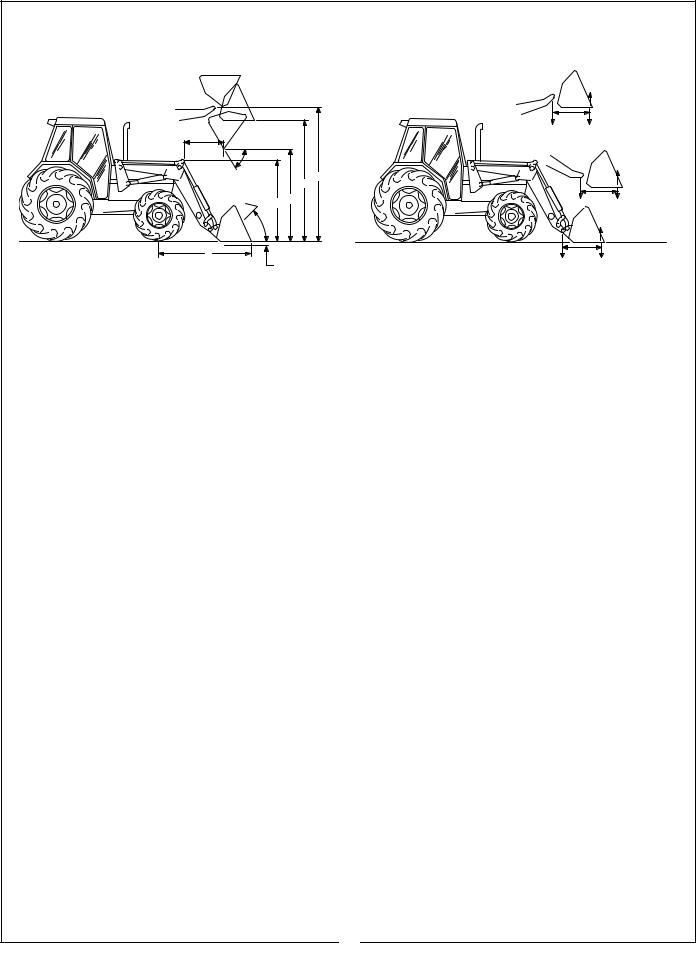
Table 1-1 TECHNICAL SPECIFICATIONS
|
|
|
VV |
|
U |
|
V |
D |
|
|
|
E |
|
|
|
|
A |
|
XX |
|
|
|
|
|
B |
|
|
J C |
|
W |
X |
G |
|
|
ZZ |
F |
|
|
|
H |
Y |
|
Z |
|
|
|
SERIES LOADER |
2426QT |
2446QT |
2846QT |
3226QT |
|
|
|
|
|
|
|
A. Maximum Lift Height - Measured at Pivot Pin |
117 in. |
117 in. |
137 in. |
143 in. |
|
B. Maximum Lift Height - Under Level Bucket |
108 in. |
108 in. |
128 in. |
134 in. |
|
|
|
|
|
|
|
C. Clearance with Attachment Dumped 45° |
89 in. |
89 in. |
109 in. |
115 in. |
|
|
|
|
|
|
|
D. Reach at Maximum Height |
26 in. |
31 in. |
28 in. |
28 in. |
|
|
|
|
|
|
|
E. |
Maximum Dump Angle |
50° |
50° |
50° |
50° |
F. Reach with Bucket on Ground |
62 in. |
65 in. |
76 in. |
73 in. |
|
|
|
|
|
|
|
G. |
Maximum Rollback Angle |
25° |
25° |
25° |
25° |
|
|
|
|
|
|
H. |
Digging Depth |
4.5 in. |
4.5 in. |
5.5 in. |
4.5 in. |
|
|
|
|
|
|
J. Overall Height in Carry Position |
59 in. |
66 in. |
74 in. |
69 in. |
|
|
|
|
|
|
|
U. Lift Capacity to Maximum Height - At Pivot Pin |
2990 lbs. |
2870 lbs. |
3560 lbs. |
4110 lbs. |
|
|
|
|
|
|
|
V. Lift Capacity to Maximum Height - 31.5” |
1920 lbs. |
1985 lbs. |
2475 lbs. |
2800 lbs. |
|
|
Forward of Pivot Pin |
|
|
|
|
|
|
|
|
|
|
W. Lift Capacity to 59” Height - At Pivot Pin |
4130 lbs. |
3220 lbs. |
4090 lbs. |
4410 lbs. |
|
X. Lift Capacity to 59” Height - 31.5” |
3020 lbs. |
2390 lbs. |
3105 lbs. |
3360 lbs. |
|
|
Forward of Pivot Pin |
|
|
|
|
Y. Breakout Force - At Pivot Pin |
4985 lbs. |
3955 lbs. |
5030 lbs. |
5160 lbs. |
|
|
|
|
|
|
|
Z. Breakout Force - 31.5” Forward of Pivot Pin |
3500 lbs. |
2940 lbs. |
3630 lbs. |
3730 lbs. |
|
|
|
|
|
|
|
VV. Rollback Force at Maximum Height - |
2400 lbs. |
3155 lbs. |
4420 lbs. |
4940 lbs. |
|
|
31.5” Forward of Pivot Pin |
|
|
|
|
|
|
|
|
|
|
XX. Rollback Force at 59” Height - |
3340 lbs. |
3880 lbs. |
5505 lbs. |
6865 lbs. |
|
|
31.5” Forward of Pivot Pin |
|
|
|
|
ZZ. Rollback Force at Ground Level - |
2710 lbs. |
3015 lbs. |
4020 lbs. |
5305 lbs. |
|
|
31.5” Forward of Pivot Pin |
|
|
|
|
|
|
|
|
|
|
|
Raising Time - Ground Level to Full Height |
6 sec. |
4 sec. |
7 sec. |
5 sec. |
|
|
|
|
|
|
|
Lowering Time - Full Height to Ground |
3 sec. |
3 sec. |
4 sec. |
3 sec. |
|
|
|
|
|
|
|
Bucket Dumping Time - Full Rollback |
3.5 sec. |
4 sec. |
5 sec. |
5 sec. |
|
to Full Dump |
|
|
|
|
|
|
|
|
|
|
|
Bucket Rollback Time - Full Dump |
2 sec. |
2.5 sec. |
3 sec. |
3 sec. |
|
to Full Rollback |
|
|
|
|
|
|
|
|
|
|
Tractor HP Range |
35 - 75 |
35 - 75 |
60 - 90 |
70 - 120 |
|
|
|
2 WD |
2 & 4 WD |
2 & 4 WD |
2 WD |
|
|
|
|
|
|
Based On Tractor Hydraulic System: |
|
|
|
|
|
|
P ressure |
2450 psi |
2450 psi |
2450 psi |
2450 psi |
|
Flow |
11 gpm |
11 gpm |
11 gpm |
16 gpm |
9
